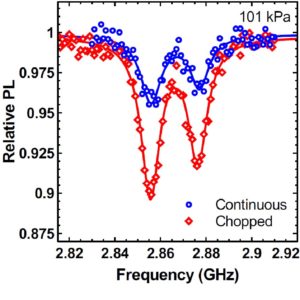 It is now appreciated that the optical trapping, levitation and control of nano- and microparticles has opened a new frontier in optomechanics (see left for image of a levitated mechanical oscillator). Much of the novelty of levitated optomechanical systems is a result of their being detached from any support or handle substrate. The physical impact of the previous enables the realization of mechanical resonators that are small (on the order of 1021 to 10-24 m3) while at the same time immune to the typical dissipation channels that plague conventional optomechanical systems. They are anticipated to exhibit quality factors approaching 1012 and force sensitivities approaching 10-21 N/ √Hz. All the previous features make levitated mechanical oscillators ideal for applications in quantum science, to test foundational questions regarding quantum mechanics as well as a unique platform for technology applications in sensing and timekeeping.
It is now appreciated that the optical trapping, levitation and control of nano- and microparticles has opened a new frontier in optomechanics (see left for image of a levitated mechanical oscillator). Much of the novelty of levitated optomechanical systems is a result of their being detached from any support or handle substrate. The physical impact of the previous enables the realization of mechanical resonators that are small (on the order of 1021 to 10-24 m3) while at the same time immune to the typical dissipation channels that plague conventional optomechanical systems. They are anticipated to exhibit quality factors approaching 1012 and force sensitivities approaching 10-21 N/ √Hz. All the previous features make levitated mechanical oscillators ideal for applications in quantum science, to test foundational questions regarding quantum mechanics as well as a unique platform for technology applications in sensing and timekeeping.
 A particular fruitful application of levitated optomechanics is the realization of levitated optomechanical systems that contain intrinsic quantum degrees of freedom, so-called hybrid systems. Hybrid systems provide a novel platform to interface phonons, spins and photons. We have recently demonstrated such a system by working with a nanodiamond that contained a single nitrogen vacancy center defect. The defect engenders the levitated nanoparticle with an internal optical resonance that can be exploited to measure and control the defect’s spin. The left illustrates optically detected magnetic resonance as measured on a single nitrogen vacancy center in a levitated nano diamond. The interest in hybrid systems is multi-faceted since they present unique opportunities in quantum science and metrology.
A particular fruitful application of levitated optomechanics is the realization of levitated optomechanical systems that contain intrinsic quantum degrees of freedom, so-called hybrid systems. Hybrid systems provide a novel platform to interface phonons, spins and photons. We have recently demonstrated such a system by working with a nanodiamond that contained a single nitrogen vacancy center defect. The defect engenders the levitated nanoparticle with an internal optical resonance that can be exploited to measure and control the defect’s spin. The left illustrates optically detected magnetic resonance as measured on a single nitrogen vacancy center in a levitated nano diamond. The interest in hybrid systems is multi-faceted since they present unique opportunities in quantum science and metrology.
